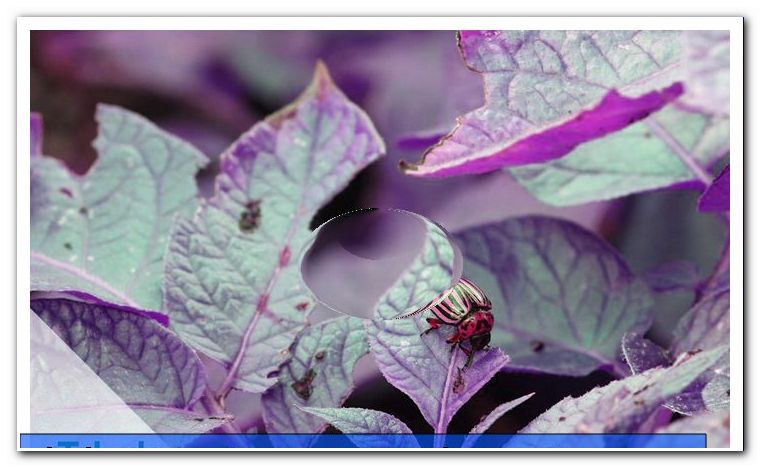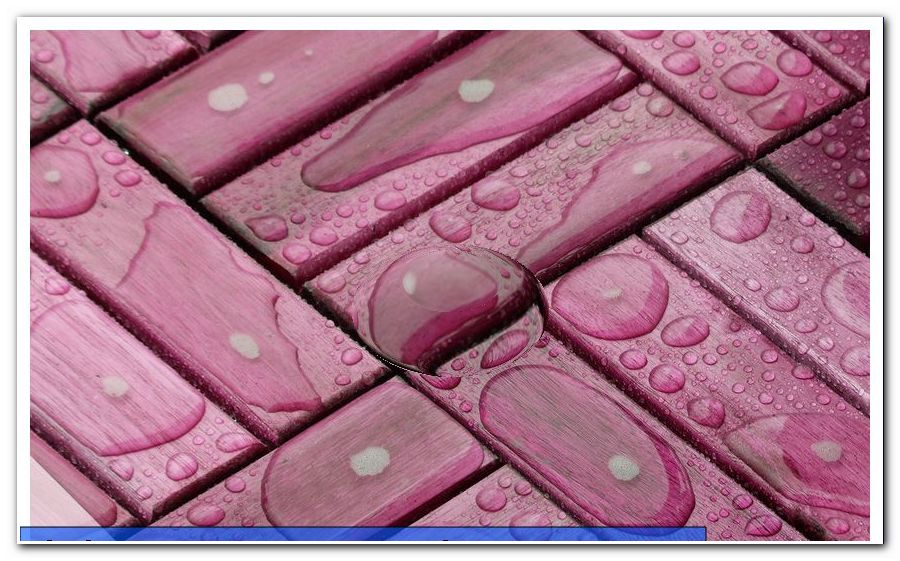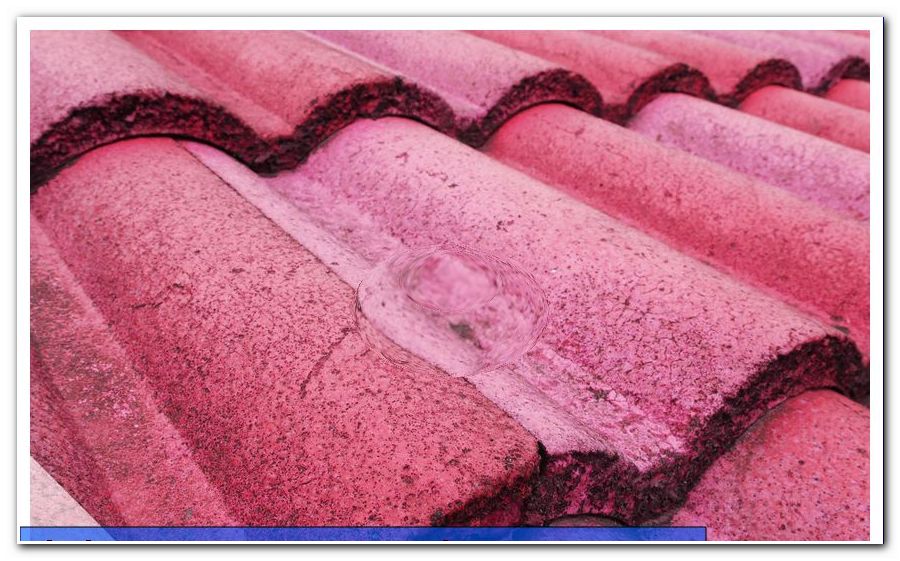Naturally fight potato beetles

- Characteristics
- development
- Harming
- ID
- Most effective method: collecting
- The best home remedies
- 1. Rock flour or wood ash
- 2. Mint and fern
- Ecological control methods
- 1. Niemöl (Neemöl)
- 2. Special bacteria
- The last resort
- Preventive measures
These potato beetles do not bear their name for nothing: they love potatoes hot and hearty - and they prefer to eat their leaves. This behavior does not exactly make them popular. To top it all off, the eye-catching yellow-and-black striped beetles are also fantastic aviators, so their spread is almost impossible to prevent. The result borders on a catastrophe: they destroy entire potato fields in a short time.
Potatoes are high on our list of staples. Every German consumes more than 60 kg of potatoes and potato products every year. So it is not surprising that a large part of the commercial and private land used for potato cultivation. If potato beetles are spotted here, there is an urgent need for action. But who wants to fight Colorado beetle, should not do the same with the chemical club, but with wisdom and wisdom. Because: A panacea against Colorado beetle does not exist. Even the worst poison does not help in any case, as Colorado beetles have proven to be extremely persistent and unruly. Best methods are therefore suitable that fight the Colorado beetle in a relatively natural way.
Characteristics
- scientific name: Leptinotarsa decemlineata ("ten-strip light foot")
- Insect family: leaf beetle (Chrysomelidae)
- Body length: 7-15 mm
- striking coloring as a warning costume against predators
- Body color: Yellow with ten dark vertical stripes on the elytra
- Damage to nightshade plants such as potatoes due to feeding activity
- In the event of danger, excrete a weir secretion
- are among the most significant pests in agriculture
- are originally from Colorado / USA
development
Targeted control of the Colorado beetle can be more effective the better the gardener is familiar with the life of the pest. Colorado potato beetles deposit several hundred eggs in June from 20 to 80 yellow single eggs on the underside of potato plants or other nightshades. After about a week, the reddish-brown larvae hatch with black heads and small black spots on the body side. Potato beetle larvae grow very fast and crawl into the soil after pupation after two to four weeks. The Colorado potato beetles, which hatch after about two more weeks, remain in the ground for at least another week. Thus, up to three generations of Colorado beetle can develop each year. For hibernation, the Colorado beetles hide in the ground.

Harming
The first two larval stages of the Colorado beetle practically do not cause any significant damage to the host plant. Only the more mature larvae are the actual pests, which lead with their freshman so far to Kahlfraß that only thicker stems of the potato plant remain.
- buchtige notches on the leaf margins or holes in the leaves, usually the thicker leaf veins remain
- in the worst case, the entire plant is eaten bare except for the stems and thicker lateral shoots (skeletal feeding)
ID
In order to apply a suitable control measure, the pest must first be clearly identified. This is relatively easy with potato beetles:

- adult Colorado beetle: 7 to 15 mm in length, yellow color, 5 black longitudinal stripes per wing, black spots on the pronotum (no confusion possible)
- Turning over the leaves gives you yellow or orange egg packets on the underside
- on the underside of the leaves sit tiny, brown-black larvae
- on the leaves sit (in smaller groups) the red-brown larvae with black head and black spots on the side
Tip: Colorado beetles not only infect potatoes, but also tomatoes, eggplants, peppers and tobacco plants. A regular control of these plants on eggs, larvae and beetles is therefore appropriate.
Most effective method: collecting
A very effective, but tedious way to get rid of the annoying Colorado beetle, is certainly the picking by hand. So that the beetles do not immediately fly away or crawl out, it is recommended to collect a glass with a lid or a bucket, over which a cloth is slipped. However, the diligent collector must not forget the eggs on the underside of the leaves (yellow egg packets) and must also brush the larvae in all stages from the underside of the leaves. By the way, collecting works best in the early morning hours, then the larvae are less mobile. The procedure should be repeated at intervals. To kill you can just leave the glass with the lid closed until the Colorado beetles and their offspring die, but it can be faster if they are thrown into an open flame or on the fire embers.
The best home remedies
The Colorado beetle is considered one of the most important pests in agriculture. Especially in dry and warm weather in spring and summer, the damage to the potato plants are enormous. Agricultural holdings usually rely on insecticides, which, however, often lead to resistance in the potato beetles in a very short time. Responsible hobby gardeners should make it their ultimate goal to harvest healthy and unencumbered potatoes from their own garden and fight the Colorado beetle, of course.

1. Rock flour or wood ash
In the fight against the Colorado beetle, simple remedies such as rock flour or wood ash can also help. So if you throw your barbecue, you can collect the ashes in a bucket and sprinkle on the potato plants. Rock flour, also called rock salt, is in principle nothing but finely ground rock. Since the rock used is a high percentage of silicic acid and also contains important nutrients for the crop, primary rock meal is used as a natural fertilizer. But it also helps against Colorado beetles. Both substances - dry wood ash or rock flour - are sprinkled early in the morning over the potato or tomato plants by hand. It's best if the plants are still slightly moist. In addition, the leaves are still relatively vertical upward at this time, so that the flour also comes to the leaf undersides. The plants do not harm rock flour, the larvae are deprived of body fluid and "burned".
Tip: The whole thing works well with dried coffee grounds, which is sprinkled on the damp leaves.
2. Mint and fern
The spraying with mint or fern extracts has proved to be effective. For spraying with the flower syringe, a kind of tea is applied to the undersides of the leaves. If you would like to use this method, of course, you should have a larger bush of peppermint or ferns in the garden, to which you can remove some shoots or fronds for this purpose. For the tea, roughly half a bucketful of mint or fern froth is roughly minced and doused with 5 liters of boiling water. After cooling, remove the solid components and dilute the "tea" 1:10 with cold water (100 ml of tea plus 900 ml of water). Then the broth can be sprayed on the potato plants (leaf underside), preferably early in the morning or in the evening on a rain-free, but not very hot day.
Ecological control methods
While conventional farming is still battling the Colorado potato beetle with chemical insecticides - and with modest success as the Colorado potato beetles are resistant to the active ingredients - organic farmers seem to be taking it one step further and combating the Colorado beetle by natural means. These methods prove to be efficient in the long term and, above all, environmentally friendly. At them also the hobby gardener should orientate.

1. Niemöl (Neemöl)
As pesticides from many different companies (such as Natures Bio-pest free from Celaflor) on the market. The products contain neem oil with the active ingredient azadirachtin, which is produced from naturally renewable raw materials (component of the seed of the neem tree). The active ingredient is not harmful to bees and has a broad spectrum of activity, but only on the clutch and not on the beetle. Therefore inject as soon as possible after oviposition.
Tip: The Information System Integrated Plant Production (www.isip.de) collects every year an infestation survey and prognosis for occurring Colorado beetle beetles in Germany and gives advice on when regional spraying should be done. Registration required (the system is called SIMLEP).
2. Special bacteria
A special bacterium called Bacillus thuringiensis also occurs naturally in the soil. This bacterial species acts as a pathogenic agent in certain insects, such as the Colorado potato beetle. Thus, the agent can be used specifically against an infestation with potato beetles, without damaging other animals or organisms. The bacterium (contained in, for example, Novodor FC) causes the larvae to die within hours. 1 liter costs about 18 euros and is enough for about 3000 square meters.
Tip: Incidentally, most Colorado beetles are largely resistant to the previously used, harmless active ingredients from the chrysanthemum (called pyrethrins).
The last resort
If nothing works, you can also use spinosad. This active ingredient is derived from a bacterium and is permitted in organic farming. However, the agent is dangerous for bees and should therefore be used wisely.
Preventive measures
In the natural and environmentally conscious fight against Colorado beetles, it's all about the plague in the long run to master. Already in advance, a lot can be done to ensure that it does not even come to an infestation with potato beetles. Foresighted hobby gardeners tackle the problem from all sides.

- never plant potatoes again on the same bed the following year
- Cultivate potatoes in mixed culture: plant cumin, horseradish, peas, spinach or peppermint repeatedly between the rows (mixed culture strengthens and protects the potato plant)
- regularly remove weeds and rake the soil between rows (taking natural protection from the larvae)
- tightly meshed nets stretch across the beds (prevents the ingress of adult Colorado beetles)
- Plant new potatoes instead of later varieties (less susceptible to Colorado beetles due to the shorter ripening period)
Tips for quick readers:
ID
- Beetle: 7-15 mm tall, yellow colored with black stripes on the wings
- Eggs: clutch of 20-80 pieces, yellow orange, on the underside of leaves
- Larvae: depending on the stage brown or red with black head and black spots on the side
Most effective control method: Absammeln
home remedies
- Rock flour or wood ash
- dried coffee grounds
- Broth of mint or fern
Means in organic farming
- neem oil
- Bacterium Bacillus thuringiensis
- Spinosad (bees dangerous)
prevention
- Pay attention to crop rotation (never plant potatoes again in the following year)
- Mixed cultures with mint, caraway, horseradish or spinach
- tension fine meshes
- Rake the area frequently and remove the weeds
- Grow new potatoes or resistant varieties




